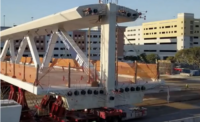Transportation
Settlement Issues Bog Down Louisiana Bridge Project, Resulting in Daily $10K Fines

The development team constructing the Belle Chasse Bridge near New Orleans is being fined $10,000 per day after excessive settlement issues necessitated reconstruction that could cost $2 million or more.
Photo courtesy Louisiana Dept. of Transportation and Development
Excessive ground settlement issues have bogged down progress on the new $171-million Belle Chasse Bridge in Louisiana, pushing its originally scheduled April 2024 completion to February 2025 and leading to $10,000-per-day fines for the developer.
Routine construction inspections conducted in late June for the new 3,400-ft-long crossing of the Gulf Intracoastal Waterway southeast of New Orleans discovered that recently built precast, pre-stressed concrete girder approaches for the bridge’s two-lane northbound span had settled beyond design specifications.
Project spokesperson Angela Noote says that while some ground settlement is expected due to Louisiana’s unique geological and environmental conditions, “this particular settlement has exceeded our initial expectations.”
Although the extent of the ground settlement and repair strategy are still being evaluated, Noote says the current planned mitigation includes replacing the approaches. That process could take eight to 10 weeks, dependent on approval of remediation plan, and cost more than $2 million, she adds.
In addition to bearing the cost of the settlement mitigation, the development team is being assessed $10,000 in daily liquidated damages for missing the original target completion date. If the team meets the new date of Feb. 10, 2025 for final acceptance by the state, fines would total about $3 million.
The new bridge’s two-lane southbound span was opened to traffic last December, and is unaffected by the ground settlement issue.
Begun in 2020, the Belle Chasse Bridge project is the Louisiana Dept. of Transportation and Development’s first construction effort to use a public-private partnership, led by the Plenary Infrastructure Belle Chasse development consortium under a 30-year design-build-finance-operate-maintain agreement. A joint venture of Traylor Bros., Inc., and Massman Construction Co. is serving as contractor.
With a 73-ft vertical clearance and 150-ft wide horizontal clearance to accommodate shipping traffic, the new bridge with a three-span continuous steel unit over the waterway replaces a 56-year-old, 2,654-ft-long vertical-lift bridge and parallel 1,938-ft-long 1950s-era tunnel, both of which required increasingly frequent and disruptive repairs.
Since the opening of two-lane southbound span, the project team has decommissioned and walled off the tunnel, which was locally notorious for its persistent leaks. The existing vertical lift bridge, which continues to carry northbound traffic over the waterway, will be demolished once the new bridge is complete. A new electronic tolling system for the crossing will be activated at that time as well.


